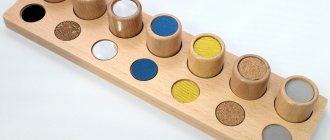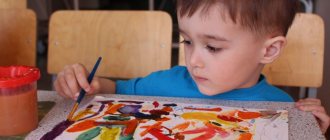Preview:
Summary of an individual lesson on visual arts with a young child
Development of the functional capabilities of the hands and fingers through artistic activities.
- Establish positive emotional contact with the child,
- To develop visual skills;
- Expand your stock of general ideas about the environment, vocabulary;
- Form perceptual actions to examine surrounding objects and adequately reflect reality (looking, feeling, listening); the ability to perform coordinated actions of both hands; differentiated movements of the hands and fingers;
- Develop hand-eye coordination.
- visual (showing - imitation - joint actions; observation, visual-perceptual examination of objects);
— practical (subject actions, game tasks);
- verbal (rhymes, songs, etc.).
The most effective techniques in pedagogical work with young children are the following:
• emotional-speech influence (clear and concise instructions from an adult, commenting on all actions with objects and toys, changes in intonation, pitch and modulation of the voice; affectionate look; use of nursery rhymes, songs, etc.);
• tactile influence (stroking, demonstrating a friendly attitude, affectionately calling the child by name, eye-to-eye contact, etc.);
• encouragement (praise, the opportunity to play with a new toy after class or take a toy home);
• attracting attention (a surprise moment; objects that include elements of novelty, surprises based on entertainment);
Finger gouache, large sheet of paper, toy cockerel.
- Before starting work with your child, prepare only what will be needed directly during the lesson. The first condition for successfully conducting classes with children is that everything necessary must be prepared in advance.
- The duration of classes is 5-20 minutes or more, depending on the age, mood and desire of the child. Individual lessons. Group lessons with 2-3 mother-child pairs are possible only after the child gets used to the teacher and masters the technique of working with paints.
- We don’t use water because a child might spill it.
It should be noted that in the course of systematic pedagogical work on the formation of objective actions in children the following appears:
• the need to understand the surrounding reality;
• positive emotional attitude towards objects, toys;
• interest in cooperation with adults and in actions with objects;
• the desire to independently act with objects in accordance with their functional purpose.
Summary of a drawing lesson for young children: “Stars in the sky”
Target:
- continue to exercise children’s ability to use paints (gouache);
— teach children to draw stars using an unconventional drawing method (with cotton swabs);
- strengthen children’s ability to distinguish and name colors;
- develop fine motor skills of the hands, attention, ability to navigate in space;
- cultivate independence and accuracy when performing tasks.
Materials: sheets of A 4 paper with an image of the night sky with the moon and houses (for each child), white gouache, cotton swabs, rags, napkins for cotton swabs, a homemade star toy.
Progress of classes with young children in kindergarten:
I. Organizational moment
The teacher invites the children to sit on the chairs.
II. Main part
Educator: Children, today a star came to visit us. The little star wants to tell us her story. When the sun sets and it becomes dark around, all the children go to bed in their beds. And then the moon appears in the sky, and with it the first star. And how lonely she is there, because she is alone, and she has no friends with whom she could play and talk. That's why the star asks us to help her - to draw her girlfriends, as bright and beautiful as she is. Let's help our guest. Do you agree? (Children's answers)
The teacher demonstrates a star toy with a sad expression on his face.
Educator: Children, which star is sad or happy? (Children's answers)
Educator: What color is it? (Children's answers)
Educator: Now children, take your chairs and sit at your tables.
Educator: Look at this drawing. What's on it? (If necessary, the teacher helps the children answer that the picture shows the night sky with the moon, stars and houses.). I had already drawn stars on it in advance - girlfriends for our guest.
Educator: What color is the sky? (Children's answer: blue)
Educator: What color is the month? (Children's answer: yellow)
Educator: What color are the stars? (Children's answer: white)
Educator: It is with the help of white paint that we will paint stars - girlfriends for our guest.
Educator: We will paint not with a brush, but with a magic cotton swab. (The teacher shows and explains the technique of drawing with a cotton swab.)
Educator: I carefully dip a cotton swab into white paint, trying not to stain everything around with paint, and put a dot in the sky - this will be our star. More and more stars appear in our sky. Look how many of them there are already! The radiance of our stars illuminated the entire sky!
The teacher invites the children to draw their own girlfriends - stars for the guests.
While completing the task, the teacher approaches those children who need help and shows them, along with a star, on his sheet of paper how to draw stars correctly.
Then the teacher hangs the children's drawings on the easel, and together with the star they look through and evaluate them.
Educator: Asterisk, are you glad that you now have many new girlfriends - asterisks? (The teacher changes the sad expression on the face of the star toy to a cheerful one.)
Asterisk: Yes.
Educator: You see, now she is not sad, but cheerful. The little star wants to play an interesting game with you.
Outdoor game "Day - Night".
Goal: to train children in the ability to act on a signal from the teacher; develop the ability to navigate in space; cultivate attentiveness.
Progress of the game: If I tell you “day,” then you all run and walk, and if I say “night,” then you stop in place, squat down on your knees, put your hands under your cheeks and close your eyes. (The game is repeated 2 - 3 times.)
III. Bottom line. Reflection
Educator: What did we do today?
Educator: What exactly did we draw?
Educator: And for whom did we draw stars?
Educator: What did we use to draw stars in the sky?
Educator: The little star thanks you for drawing such gorgeous girlfriends for her and also playing with her. Goodbye, star.
On the topic: methodological developments, presentations and notes
Comprehensive classes for teaching children to draw are built on a combination of various types of activities (familiarization with nature, art, visual arts, games) with various directions.
How to introduce kids to traffic rules.
Summary of a drawing lesson in the early age group “Wheels for a car.”
Summary of an open lesson on art activities in an early age group. “Soap bubbles.” Teacher of the MKDOU “Belozersky kindergarten” Vera Vasilievna Zavgorodnyaya.
“Infant drawing” (from 6 months to 1 year)
GOU TsRR kindergarten No. 000 YuOUO Moscow
"Baby drawing"
(from 6 months to 1 year)
Goals and objectives:
Using finger paints at such an early age (from 6 months to 1 year), there is no need to try to teach a baby to draw in the literal sense of the word. This is a rather pragmatic goal, which may not justify itself, because the child will master drawing techniques much later. For now, we just give the baby the opportunity to tinker with paints
· Children really enjoy playing with paints, and their good, upbeat mood is already a sufficient success for any activity.
· Drawing in this “manual” way contributes to the development of cognitive mental processes in the child. This means that the child will develop better speech, memory, and thinking.
· In the process of drawing with fingers and palms, vision and touch are involved, therefore, visual perception (perception of color, shape and space) and tactile sensations (feeling the thickness and consistency of paint with the fingertips, etc.) develop.
· In addition, while painting with finger paints, fine motor skills are actively developed, and precise movements of the fingers and hand are improved.
· When painting with finger paints, children most often use both hands. There is no need to limit them in this. After all, the simultaneous work of both hands masters and strengthens the connections between the right and left hemispheres, and hence the leap in development that is immediately visible to parents and educators who use drawing with fingers and palms in play with infants.
· Working with paints develops a child’s artistic taste, develops aesthetic qualities, and teaches him to observe and compare.
To make the perception more voluminous and complete, and the sensations sharper, you can connect drawing with music - include Bach, Beethoven, Mozart in a special arrangement for children.
Materials for infant drawing:
We use special finger paints: “Gamma” (Russia) and imported “SES”, “JOVI”, etc., A-3 paper (A-4 is also possible). These paints are safe and non-toxic, even if they get into the baby's mouth (which very often happens when painting). At home, we recommend that parents use large sheets (for example, pieces of old wallpaper). For kindergarten classes, your child will need an oilcloth apron with sleeves (sold at IKEA) to protect their clothes.
How to conduct classes:
The child sits in his mother’s arms; it is better to place the paints on a flat surface (a saucer or a plastic lid for watercolor paints), so it is easier for the child to pick up the paint. Before starting to draw, we show the child an object of a certain color and name it, then show paint of the same color and again name the color. In the first lesson, we give one color and introduce paint as a visual material. To do this, the mother first draws, and then we dip the child’s fingers in the paint and give him the opportunity to feel the consistency of the paint and examine his fingers. Let us draw with both hands. During the first lessons, the child should be shown how to smear paint on a sheet. Over time, he will manipulate the paint and paper himself. Gradually in classes we increase the number of colors (up to 4 main ones: red, blue, green,
yellow; We give white for drawing on a colored background). But the rule always remains - we correlate the color of the object and the paint, repeating several times.
We give the child the opportunity to choose the color himself. During the drawing process, be patient and take an observer position. Accept this extraordinary creativity for what it is. It is very important to encourage the child’s activities from an adult and praise. The child’s activity will largely depend on the adult’s emotional mood. After the child has already become familiar with a new object (paint), it is good for the mother to paint at the same time as the child (!!! only on a separate sheet). A necessary condition for a successful creative process is the child’s ability to observe the activities of an adult.
For most children, active actions occur in the second, third lesson and later. Children really like to move their hand, while the baby makes wide, sweeping movements characteristic of this age. The child's attention is attracted by smudges, new sensations when touching paint, and the sound of squeezing when squeezing the paint in his palm. It should also be taken into account that at this age cognition is carried out through touch. When a child tries to put paint in his mouth, explain the purpose of the paint (to draw, not to eat).
As the child grows, the drawing technique changes, and the baby’s movements become more organized. Rhythm acts as an organizing principle. Repeated hand clapping on the paint replaces active smearing, causing even greater delight. Only after a while will the child pay attention to the color spots - the result of his work. Interest in the trace left behind can be considered the beginning of real creative activity.
The work of a baby should not be subjected to thorough psychological analysis and its character should not be judged. Undoubtedly, the child’s internal state influences the choice of paints, but when assessing the work, it is necessary to take into account not only the child’s age, but also how long the child paints with paints, in order to assess whether he could independently choose the colors that he needs at the moment.
Classes in kindergarten are held once a week. The first classes are usually the shortest and will last only 2 - 3 minutes. With regular training, by the age of one year, this time increases tenfold. During the drawing process, it is very important to monitor the reaction and emotional mood and state of the child, since he himself acts as a temporary barometer of the duration of classes. A sudden deterioration in mood or attempts to scatter paper and paints is a signal to end the lesson.
Approximate long-term planning
| Age | The content of the work | Forms of work |
| Work with children | ||
| 6-9 months | “Games with paints” - painting with your palm and fingers. Research activity of a child, communication between a child and an adult, psycho-emotional development, development of color perception, development of attention, development of fine motor skills. Contents of classes: Getting to know paint as a visual material, paper. Freely smear paint on paper with your palm or fingers. The child is on the mother's lap and she encourages the child to manipulate the paint. Getting to know color at the associative level. Individual lessons. | Game activities |
| 9-12 months | “Games with paints” - painting with your palm and fingers. The child’s research activity, the child’s communication with adults, psycho-emotional development, the development of color perception, the development of attention, the development of fine motor skills, the development of the child’s “passive speech”. Contents of classes: The first lesson is free manipulation with paints. Then, at each lesson, we get acquainted with color at an associative level - a yellow sun and yellow paint, a blue ball and blue paint, etc. The child is first on the mother’s lap, and then he can be seated on a separate chair, with his mother next to him. Classes are first individual, and then perhaps in a group of 2 - 3 children with their mothers. As children approach one year of age, they watch each other with interest and the less active ones begin to imitate the more confident “artists.” | Game activities |
Approximate topics of classes.
Lesson 1:
“
Introduction to paint”
– as a visual material, paper. Freely smear paint on paper with your palm or fingers.
Lesson 2
:
“Traces on paper.”
P.S.:
Encourage your child to be interested in manipulating paint. Research activity of a child, communication between a child and an adult, psycho-emotional development, development of color perception, development of attention, development of fine motor skills.
Lesson 3:
“Yellow leaves”
P. p.:
Development of color perception. Encourage your child to be interested in manipulating paint.
Lesson 4:
“Yellow Sun”.
P.S.:
Development of color perception. Encourage your child to be interested in manipulating paint.
Lesson 5: - “Your palm, my palm”
P.S:
Co-creation of mother and child. A mother’s palm leaves a large mark, but a child’s – a small one.
Lesson 6: - "Green crocodile"
P.S.:
Getting to know the color green.
Lesson 7: – “Green Lawn”
P.S.:
Introducing the color green - the color of grass. Fill the sheet with colorful spots of green.
Lesson 8: - “Blue Ball”
P.S.:
Introducing the color blue, fill the sheet with colorful spots of blue.
Lesson 9: - “White clouds float across the sky”
P.S.:
White color - familiarity. Paint spots with white paint on a blue background.
Lesson 10: – “Red Flowers”
P.S.:
Getting to know the color red; draw red spots on a green background.
Lesson 11: – “The red ball hid in a blue chest”
P.S.:
We give the child two colors at once. First, the game moment - we hide the red ball in the blue chest. We show the child the chest - name the color, open the chest - take out a red ball.
Lesson 12: - “Here’s a rattle”
P.S.:
We give three colors at once.
In the future, classes are based more and more on the children’s independent choice of colors (we give 3-4 colors) and without preliminary showing of objects, but we continue to name the colors of the paints.
Diagnosis of young children by drawing
(6 months - 1 year)
(finger painting)
Teacher: ____________________________
During the period:_________________________________
| Child's name | age | Mother's attitude to the child's creative work | The child’s attitude towards this type of activity | Sheet filling level | Number of colors used | Drawing time |
We carry out diagnostics once every 3 months.
Drawing classes
with young children (6 – 9 months and 9 – 12 months)
using stencil frames.
"Gift for Dad"
Purpose of the lesson:
Research activity of a child, communication between a child and an adult, psycho-emotional development, development of color perception, development of attention, development of fine motor skills.
Materials for the lesson:
Special finger paints (blue and green), white sheets of A4 paper, “Boat” stencil frames for each child.
Progress of the lesson:
We show the child a toy boat (plain, plastic), name the color, repeat several times, then show paint of a similar color (we put a small amount of paint on a plastic white palette - lids from boxes of watercolor paints are very suitable for these purposes) and again name the color. Then we invite the child to leave traces of paint on the white paper - first the teacher shows how to touch the paint and at the same time says that the paint is such and such a color, then if the child himself does not reach for the paint, then the mother helps the child touch the paint and leave marks on the paper . When the drawing is completed, we apply the “Boat” stencil onto it.
"Gift for Mom"
Purpose of the lesson:
Research activity of a child, communication between a child and an adult, psycho-emotional development, development of color perception, development of attention, development of fine motor skills.
Materials for the lesson:
Special finger paints (red and yellow or red and green), white sheets of A4 paper, “Flowers” stencil frames for each child, artificial flowers in yellow and red on a green stem and with green leaves.
Progress of the lesson:
Similar to the “Gift for Dad” activity. The main thing is to name the colors and correlate the color of the object and the paint.
"New Year card"
Purpose of the lesson:
Research activity of a child, communication between a child and an adult, psycho-emotional development, development of color perception, development of attention, development of fine motor skills.
Materials for the lesson:
Special finger paints (green, blue and yellow, red), white sheets of A4 paper, “Herringbone” stencil frames for each child.
Progress of the lesson:
Give the child the opportunity to decide on his own color preferences - to do this, put several colors of paint on the palette and name them. Then the child himself determines the paint he likes or paints with all colors of paints.
Made up
Get text






